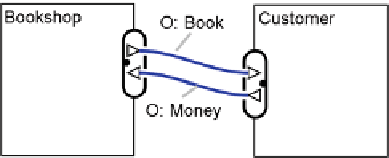Information Technology Reference
In-Depth Information
well as aspects not related to right transfer and creation. Furthermore, the concept
of custody, i.e. what actor has access to a value object, and evidence documents
involved in a value exchange, will also be incorporated in the analysis of how value
is created in an exchange. In this section, we will discuss how these additional rights
and aspects can be taken into account by extending the notation of the e3value lan-
guage, thereby enabling it to represent richer value models. We will also introduce a
number of guidelines assisting a designer in systematically enriching an initial value
model that only represents transfers of ownership.
4.1 Notation and Guidelines
In order to represent the meaning of value exchanges, the following notation will be
used:
•
A value exchange representing the transfer of ownership will be labeled with
“O”;
•
A value exchange representing the granting of a claim will be labeled with “C”;
•
A value exchange representing the granting of a privilege will be labeled with
“Pr”;
•
A value exchange representing the bestowing of power will be labeled with “Po”;
•
A value exchange representing the pleading of a claim will be labeled with “PC”;
•
A custody provision from one actor to another will be shown as a dotted arrow;
•
An evidence provision from one actor to another will be shown as a dashed arrow.
In order to support a designer in enriching a value model and making it more
precise, we suggest a number of guidelines. These aim at clarifying the kinds of
rights involved in value exchanges, the consequences of claims, and the provision
of custody and evidence documents.
Guideline 1
:
Label existing value exchanges according to the rights involved;
possibly split value exchanges in order to get a unique labeling.
A trivial example of applying this guideline is shown in Fig.
6,
which shows
a customer buying topics from a bookstore. In this case, ownership of topics and
money are transferred to the customer and bookstore, respectively.
Another example is shown in Fig.
7,
where a customer buys insurance from an
insurance company. In this case, the customer does not get any privileges to carry
out certain actions; instead, she gets a (conditional) claim on the insurance company
Fig. 6
Bookshop example

Search WWH ::

Custom Search